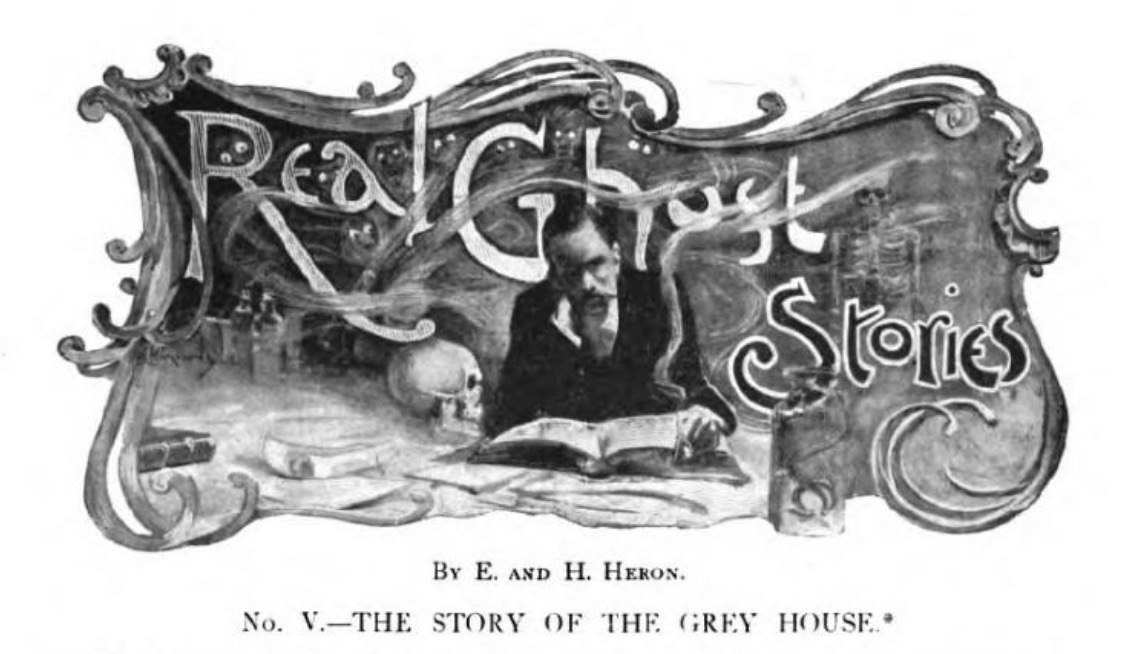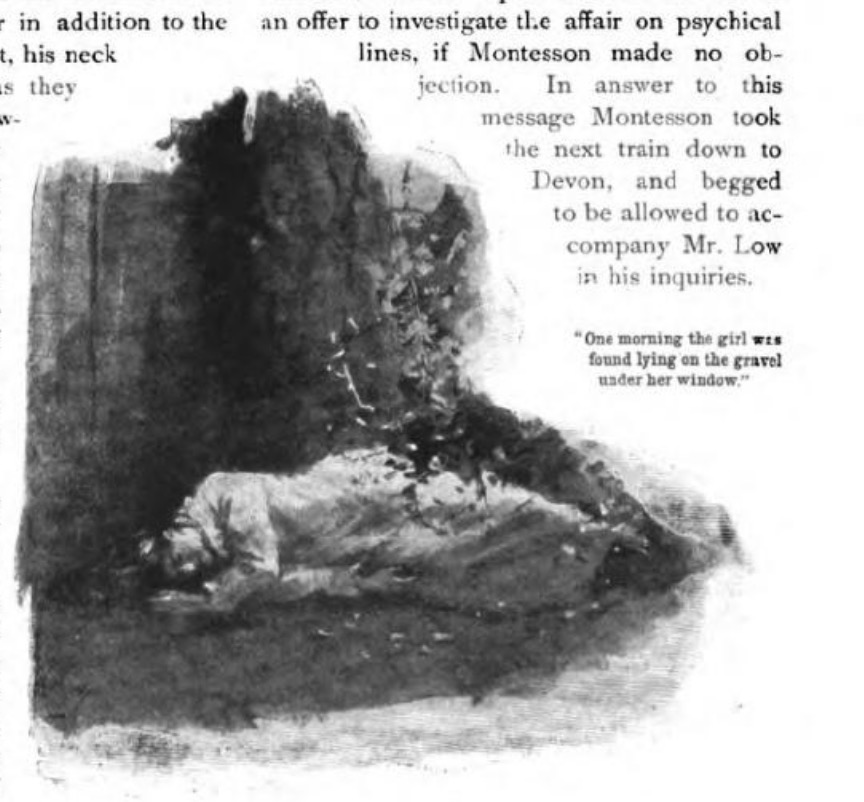THE STORY OF THE GREY HOUSE (2)
By:
September 27, 2024

HiLoBooks is pleased to serialize E. and H. Heron’s occult detective tale “The Story of the Grey House” (Pearson’s Magazine, 1898, so technically just before the sf genre’s Radium Age) for HILOBROW’s readers. Flaxman Low’s curiosity is piqued by the history of the Grey House, where numerous residents have been found mysteriously hanged… even though no rope is ever found.
ALL INSTALLMENTS: 1 | 2 | 3 | 4 | 5.
“After that all went well for a couple of years, when, during the summer holidays, the trouble began. Montesson must have been about sixteen at the time, and had a tutor with him. His mother and sister—a pretty girl rather older than himself—were also here. One morning the girl was found lying on the gravel under her window, quite dead. I was sent for, and, upon examination, discovered the extraordinary fact that she had been hanged!”
“Murder?”
“Of course, though we could find no trace of the murderer. The girl had been taken from her bedroom and hanged. Then the rope was removed, and she was thrown in a heap under her window. The crime caused a tremendous sensation in the neighbourhood, and the police were busy for a long time, but nothing came of their inquiries.

“About a fortnight later, Platt, the tutor, sat up smoking at the open study window. In the morning he was found lying out over the sill. There could be no mistake as to how he met his death, for in addition to the deep line round his throat, his neck was broken as neatly as they could have done it at Newgate! As in the other case, there was nothing to show how he came by his death, no rope, no trace of footsteps or any struggle to lead one to suspect the presence of another person or persons. Yet from the facts it could not have been suicide.”
“I see you had some suspicion of your own,” said Flaxman Low.
“Well, yes, I had. But time has passed, and I now think I must have been mistaken. I must explain that the branches of the cedar you saw jut to within a few feet of the windows of the rooms occupied by Miss Montesson and Platt respectively at the time of death. I told you there were no traces of any one having approached the house. It therefore struck me that some active person might have leaped from the cedar into the open windows and escaped in the same way, for the windows open vertically, and when both leaves are thrown back there is a large aperture. But the murders were so purposeless and disconnected that they suggested irresponsible agency. I recollected Poe’s story of the Rue Morgue, where, you remember, the crimes were committed by an ourang-outang. It seemed to me possible that Lampurt, who was of a morose and strange temper, might, among other things, have secretly imported an ape and turned it loose in the woods. I had a thorough search made in the park and grounds, but we found nothing, and I have long ago abandoned the theory.”
Low thought silently over the story for some time, then he asked for the dates of the three deaths. Fremantle answered categorically, and it appeared that all had taken place about the same season of the year—during summer, in fact. Upon this Mr. Low made an offer to investigate the affair on psychical lines, if Montesson made no objection. In answer to this message Montesson took the next train down to Devon, and begged to be allowed to accompany Mr. Low in his inquiries.
Flaxman Low quickly saw that Montesson might prove a very useful companion. He was a blonde, heavily-built man, and plainly possessed of a strong will and temper. Low put aside his books and went off at once with Montesson to have a closer look at the Grey House while the daylight lasted.
It is difficult to give any adequate impression of the teeming exuberance of wild and tangled growth through which they had to cut their way. Young, lush, sappy leafage overlay and half disguised the dank rottenness of the older vegetation beneath. After wading more than breast-high through the matted reeds, below which the spreading stream was fast reducing the land to a swamp, they emerged into a fairly open space that had once been the lawn round the house.
Here brambles and lusty weeds now grew abundantly under the untended trees. Curious shrubs and plants flourished here and there. As they came up a stoat sneaked away by a narrow footpath, nettle-grown and caked with damp, which led past blackened bushes round the house. Otherwise the place was deserted, not a leaf seemed to move in the windless heat of the afternoon. The squat, grey face of the house was scarred across by a dark-leaved creeper, hung with orchid-like red blossoms, a little to the left of which Low noticed the cedar mentioned by Dr. Fremantle.
Low drew up at the weed-twisted, sunken little gate that gave upon the lawns, and spoke for the first time.
“Tell me about it,” and he nodded towards the house.
Montesson repeated the story already told, but added further details. “From here,” went on Montesson, “you can see the exact spot where all these things took place. The upper of these two windows, surrounded by the creeper and under the shadow of the cedar, belonged to my sister’s room; the lower is that of the study where Platt died. The gravel path below ran the whole length of the house, but it is now overgrown. Has Fremantle told you of Lawrence?”
Low shook his head.
“I hate the very sight of the place!” said Montesson hoarsely; “the mystery and the horror of it all seem in my blood. I can’t forget!—My mother left on the day of Platt’s death, and has never been here since. But when I came of age I resolved to make another attempt to live here, meaning to sift the past if I got the chance of doing so. I had the grounds cleared about the house, and after leaving Oxford came down with a man of my own year, called Lawrence. We spent the Easter vacation here reading, and all went right enough. Meanwhile I had the house examined, thinking there might be a secret entrance or room, but nothing of the kind exists. This house is not haunted. Nothing has ever been seen or heard of a supernatural character—nothing but the same awful repetition of blind murder!”
After a few seconds he resumed.
“During the following summer Lawrence came down with me again. One hot evening we were smoking as we walked up and down the gravel under the windows. It was bright moonlight, and I remember the heavy scent of those red flowers——” Montesson glanced round him strangely.
“I went in to fetch a cigar. It took me some minutes to find the box I wanted, and to light the cigar. When I came out, Lawrence lay crumpled up as if he had fallen from a height, and he was dead. Round his neck was the same bluish line I had seen in the two other cases. You can understand what it was to leave the man not five minutes before, in health and strength, and to come back to find him dead—hanged, to judge from appearances! But as usual, no trace of rope or struggle or murderer!”
After some further talk, Mr. Low proposed to go into the house. It had evidently been deserted in haste. In the room once occupied by Miss Montesson her girlish treasures still lay about, dusty, moth-eaten, and discoloured. Montesson paused on the threshold.
“Poor little Fan! It’s just as she left it!” he said hurriedly.
The cedar outside threw a gloomy shade into the room, and the fantastic red blossoms drooped motionless in the stagnant air.
“Was the window open when your sister was found?” inquired Low after he had examined the room.
RADIUM AGE PROTO-SF: “Radium Age” is Josh Glenn’s name for the nascent sf genre’s c. 1900–1935 era, a period which saw the discovery of radioactivity, i.e., the revelation that matter itself is constantly in movement — a fitting metaphor for the first decades of the 20th century, during which old scientific, religious, political, and social certainties were shattered. More info here.
SERIALIZED BY HILOBOOKS: Jack London’s The Scarlet Plague | Rudyard Kipling’s With the Night Mail (and “As Easy as A.B.C.”) | Arthur Conan Doyle’s The Poison Belt | H. Rider Haggard’s When the World Shook | Edward Shanks’ The People of the Ruins | William Hope Hodgson’s The Night Land | J.D. Beresford’s Goslings | E.V. Odle’s The Clockwork Man | Cicely Hamilton’s Theodore Savage | & many others.
